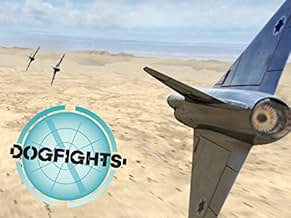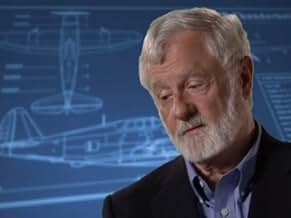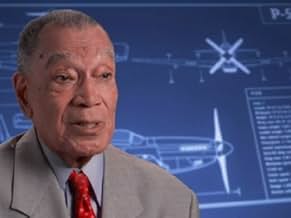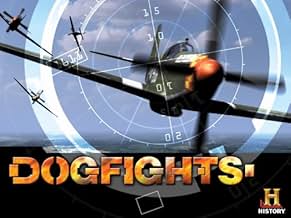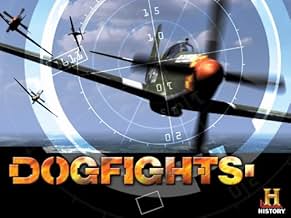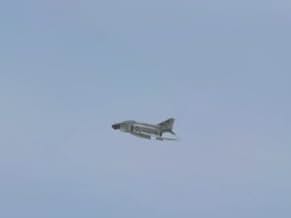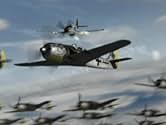Adicionar um enredo no seu idiomaUsing modern computer animation, great aerial and modern naval battles are recreated. In the process, you learn about the history of military transportation technology, the tactics created a... Ler tudoUsing modern computer animation, great aerial and modern naval battles are recreated. In the process, you learn about the history of military transportation technology, the tactics created and the people using them.Using modern computer animation, great aerial and modern naval battles are recreated. In the process, you learn about the history of military transportation technology, the tactics created and the people using them.
Explorar episódios
Avaliações em destaque
10freyw
A must-see for any aviation buff. This series uses the latest computer technology to recreate history's greatest air battles, including Guadalcanal (WWII), Mig Alley (Korea), Operation Bolo (Vietnam), the Six-Day War, and the exploits of the Flying Tigers. The series also makes good use of archival footage from the period to help illustrate the tactics and machines. The recreations are expertly done and very exciting (the "camera" even shakes when a plane flies by). Personally, I've been interested in this sort of thing since I was a kid, and this is probably the best show I've ever seen. If you like military aviation, I guarantee you won't be disappointed.
Dogfights is a little known but exceptionally informative show that used to be shown on the history channel starting in 2005. I remember seeing it for the first time around 2009, and the first thing that impressed me was how realistic it looked. I'm used to seeing camera footage of world war 2 battles, which is as close to the action as you can get. Dogfights on the other hand makes use of computer animation to accurately recreate various aerial encounters between opposing countries during wartime. The show has a lot of episodes and focuses on many different conflicts, such as world wars 1 and 2, korea, vietnam, the gulf war, and even wars between israel and several arab countries in the 1960s. What sets this show apart from other ones that are centered around plane combat is the narration. Dogfights doesn't just showcase impressive scenes of pilots dueling to the death against the cold blue sky. It also tells viewers the history behind important events, as well as explaining different flying maneuvers and techniques. One of these is called the split S. A commonly used aircraft reversal tactic, the split S involves the aircraft going inverted, diving down and pulling out of the dive in the opposite direction. This move makes it very difficult for an enemy plane chasing you to stay on your tail. Dogfights is host to a lot of episodes that I consider entertaining and important to history, such as the one where they discuss Operation Bodenplatte: Hitler's final gamble to break american airpower in western europe by sending his air force to destroy various airfields in Belgium on new year's day, 1945. The show explains in depth why the operation was a failure for the nazis, and how the americans could afford their losses while the luftwaffe had no more fuel or trained pilots. Another one of my favorite episodes focuses on world war 1, the first war ever to feature planes. By 1914, planes are just a decade old, and are used to observe enemy movements. Soon, pilots begin shooting at each other and placing machine guns on the cowling above the engine. This makes it much easier to fight since the pilot just has to aim his plane at the enemy and fire. In order to prevent bullets from shearing off their own propellers, the germans come up with a device that automatically prevents the machine guns from shooting when the propeller is right in front of the muzzles. The french manage to capture a downed german plane with the interrupter machine intact and copy it. Now, the sky battles can begin. Later on, we're shown an extraordinary incident that involves future nazi general Ernst Udet coming face to face with the talented french fighter ace Georges Guynemer. Udet is outclassed, but tries to stand and fight. His machine guns jam, and in a display of superb chivalry, Guynemer waves to him and lets him escape. This incident shows how pilots did not want to kill each other, even if that's what they signed up for. Finally, another excellent episode appears in the form of Mig Alley, which tells the story of a small area of north korea during the korean war that was destined to host the most vicious and brutal air fighting of the conflict. We are shown how on one day in 1952, american pilot "Robbie" Risner faces off against a desperate but hugely skilled north korean pilot who leads him on a wild chase all the way back to his airfield, which is over 30 miles inside china. The korean war episodes are also very interesting because this was the first war that had jet aircraft fighting other jets. Early on, we see how america easily dominates the skies and north korea's primitive, propeller-driven air force is quickly shredded. Later, the US government is shocked by the appearance of brand new, russian built Mig 15 jets, with a top speed over 100 miles per hour faster than older p-80 jets in korea. Like I keep saying, Dogfights is just a really solid series overall that focuses on some of history's most well known (and unknown) aerial combat encounters, and aviation enthusiasts will most definitely get something out of it. It does a good job of portraying how these events played out in the past, and much of the commentating is done by former pilots, people who were there, and historians.
Although the series is high in technical proficiency and detail to re-animate air battles, there is an almost complete of historical balance. The focus of most chapters is on American aviators as if they were repeating the "Mariana's turkey shot" through the ages. Only a few chapters are devoted to Israeli or German and Japanese odds-and-ends (Me-163, kamikaze, etc.). Almost no mention is done of German, Russian, Japanese, Chinese and even North Vietnamese Aces that top all-time aerial combat Aces lists. They even neglect traditional allies as the British and the French. There are very detailed accounts of aerial battles from the "other guys" point of view that should be included to have a really "Historical balance" of aerial warfare.
10bard-32
Dogfights is about the famous dogfights of World I to today. The show is based on a two-hour special that aired in late 2005. The show has chronicled the dogfights from World War II, Korea, and Vietnam. The most recent one was called Death of the Bismarck. It was about the British pilots who'd sunk the German battleship Bismarck in May 1941. There were also episodes about MiG Alley and Operation Bolo. The best episode was about the F6F Hellcat and the Japanese Zero. Another one was about the Flying Tigers. In some episodes, the actual veterans themselves, talk about their experiences. The animation is like a video game. There was an episode about the F-8 Crusader which was the last gunfighter. The F-8 was involved in a dogfight that lasted ten minutes. The longest dogfight in Vietnam. Operation Bolo was a successful attempt to lure the elusive MiG-21a into combat. The show has all the elements of a video game and this show is great.
There should be no doubt that this is a highly biased and jingoistic American program, though, to be fair, it is primarily aimed at an American audience, the concept of American military supremacy ("Americans have never and will never lose a war.") being a large part of the American identity--like it or not. Overall, I regard this series as more entertainment than a collection of historically correct documentaries. If you read official reports of the engagements portrayed in these animations you will, in many cases, discover that some significant details have been omitted or down-played for various reasons. For instance, in the second season episode with Lou Luma, the American RCAF Mosquito pilot, they fail to mention the somewhat important fact that in his portrayed strafing mission (I agree, not really dogfighting) to the German aerodrome, his tail was nearly shot off by anti-aircraft fire (http://www.acesofww2.com/Canada/aces/luma.htm).
Americans are generally fond of emphasizing their role in various wars all the while down-playing or ignoring those of their allies, especially in cases where their allies'accomplishments were as good or better. Take for instance the clear anti-British and anti-Canadian (Canadians barely mentioned) bias shown by the celebrated, though increasingly discredited, American "historian" Stephen Ambrose particularly in his books concerning the D-Day landings. Also, consider the attitude that generated the American half-joke regarding the alternate meaning of the acronym of the American Expeditionary Force (AEF) in World War 1--"After England Fails". I believe the Australians also have some legitimate complaints regarding the overshadowing of their role early on in stopping the Japanese advances in New Guinea, and their overall achievements in the Pacific Theatre during WW2. Often, it seems that General MacArthur and the American media neglected to fully acknowledge the considerable efforts of the Australians under his command.
I think it is inevitable that if this show is to continue they will have to begin focusing more on the aerial exploits of non-American allies and possibly even enemies. There has been absolutely nothing about the Russians in World War 2 (or in any conflict) which is largely inexcusable considering the prime importance of battles on the Eastern Front from mid 1941 to the end of the war (the Americans may not want to recognize the longer and possibly greater role of the Soviet forces in destroying the German Reich), and very little concerning British Empire and French dogfighters in either war which I also think is a shame. I doubt that further depictions of "dogfights" of the Korean, Vietnam and Gulf wars or Israeli-Arab conflicts will be of sufficiently broad appeal as these are more controversial in terms of the motives behind the conflicts(Americans/Israelis won't necessarily be seen as the good guys) and in most of these cases the battles don't involve true dogfighting skills. Also, I think that they have already covered a lot (most?) of the territory regarding significant American dogfights of WW1 and WW2. Any additional focus on the same will make their biases undeniable.
The Americans were "Johnny come latelies" to both of the World Wars so, I don't know how much interest the producers of this show would have in aerial battles/campaigns before their entry, or in the early days following their entry into the wars, (e.g. in the Tunisian Campaign wherein they didn't do that well in the air or on the ground), but it is certainly something to hope for.
I await the third season which I assume is now in production.
Americans are generally fond of emphasizing their role in various wars all the while down-playing or ignoring those of their allies, especially in cases where their allies'accomplishments were as good or better. Take for instance the clear anti-British and anti-Canadian (Canadians barely mentioned) bias shown by the celebrated, though increasingly discredited, American "historian" Stephen Ambrose particularly in his books concerning the D-Day landings. Also, consider the attitude that generated the American half-joke regarding the alternate meaning of the acronym of the American Expeditionary Force (AEF) in World War 1--"After England Fails". I believe the Australians also have some legitimate complaints regarding the overshadowing of their role early on in stopping the Japanese advances in New Guinea, and their overall achievements in the Pacific Theatre during WW2. Often, it seems that General MacArthur and the American media neglected to fully acknowledge the considerable efforts of the Australians under his command.
I think it is inevitable that if this show is to continue they will have to begin focusing more on the aerial exploits of non-American allies and possibly even enemies. There has been absolutely nothing about the Russians in World War 2 (or in any conflict) which is largely inexcusable considering the prime importance of battles on the Eastern Front from mid 1941 to the end of the war (the Americans may not want to recognize the longer and possibly greater role of the Soviet forces in destroying the German Reich), and very little concerning British Empire and French dogfighters in either war which I also think is a shame. I doubt that further depictions of "dogfights" of the Korean, Vietnam and Gulf wars or Israeli-Arab conflicts will be of sufficiently broad appeal as these are more controversial in terms of the motives behind the conflicts(Americans/Israelis won't necessarily be seen as the good guys) and in most of these cases the battles don't involve true dogfighting skills. Also, I think that they have already covered a lot (most?) of the territory regarding significant American dogfights of WW1 and WW2. Any additional focus on the same will make their biases undeniable.
The Americans were "Johnny come latelies" to both of the World Wars so, I don't know how much interest the producers of this show would have in aerial battles/campaigns before their entry, or in the early days following their entry into the wars, (e.g. in the Tunisian Campaign wherein they didn't do that well in the air or on the ground), but it is certainly something to hope for.
I await the third season which I assume is now in production.
Você sabia?
Principais escolhas
Faça login para avaliar e ver a lista de recomendações personalizadas
- How many seasons does Dogfights have?Fornecido pela Alexa
Detalhes
- Data de lançamento
- País de origem
- Central de atendimento oficial
- Idioma
- Também conhecido como
- Párbaj az égen
- Empresa de produção
- Consulte mais créditos da empresa na IMDbPro
- Cor
Contribua para esta página
Sugerir uma alteração ou adicionar conteúdo ausente




